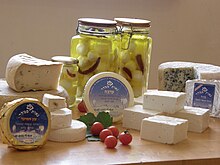Animal product


An animal product is any material derived from the body of an animal. Examples are fat, flesh, blood, milk, eggs, and lesser known products, such as isinglass and rennet.[1]
Animal by-products are carcasses and parts of carcasses from slaughterhouses, animal shelters, zoos and veterinarians, and products of animal origin not intended for human consumption, including catering waste (all waste food from restaurants, catering facilities, central kitchens, slaughterhouses and household kitchens)[citation needed]. These products may go through a process known as "rendering" to be made into human and non-human foodstuffs, fats, and other material that can be sold to make commercial products such as cosmetics, paint, cleaners, polishes, glue, soap and ink. The sale of animal by-products allows the meat industry to compete economically with industries selling sources of vegetable protein.[2]
Generally, products made from fossilized or decomposed animals, such as petroleum formed from the ancient remains of marine animals, are not considered animal products. Crops grown in soil fertilized with animal remains are rarely characterized as animal products.
Several diets prohibit the inclusion of some animal products, including vegetarian, kosher, and halaal. Other diets, such as veganism and the raw vegan diet, exclude any material of animal origin.[3]
Slaughterhouse waste
Slaughterhouse waste is defined as animal body parts cut off in the preparation of carcasses for use as food. This waste can come from several sources, including slaughterhouses, restaurants, stores and farms. In the UK, slaughterhouse waste is classed as category 3 risk waste in the Animal By-Products Regulations, with the exception of condemned meat which is classed as category 2 risk.
Food
- Blood, especially in the form of blood sausage
- Bone, including bone char, bone meal, etc.
- Broths and stocks are often created with animal fat, bone, and connective tissue
- Carmine also known as cochineal (food dye)
- Casein (found in milk and cheese)
- Civet oil (food flavoring additive)
- Dairy products (e.g., milk, cheese, yogurt, etc.)
- Eggs
- Gelatin
- Honey[citation needed]
- Honeydew (secretion)
- Isinglass (used in clarification of beer and wine)
- L-cysteine from human hair and pig bristles (used in the production of biscuits and bread)
- Lard
- Kopi Luwak & Black Ivory Coffee
- Meat (including fish, poultry, and game)
- Rennet (commonly used in the production of cheese)
- Shellac
- Swiftlet's nest (made of saliva)
- Whey (found in cheese and added to many other products)
Non-food stuff
- Animal fiber
- Ambergris
- Beeswax
- Blood and some blood substitutes (blood used for transfusions is always human in origin, though some blood substitutes are made from animal sources. Many diagnostic laboratory tests use animal or human sourced reagents)
- Casein (used in plastics, clothing, cosmetics, adhesives and paint)
- Castoreum (secretion of the beaver used in perfumes and possibly in food flavoring)
- Coral rock
- Ejaculate (used in artificial insemination)
- Feathers
- Fur
- Gallstones (from livestock for Traditional Chinese Medicine)
- Horn, including antlers, ivory, tusks, etc.
- Ivory
- Lanolin
- Leather
- Manure
- Mink oil
- Musk
- Pearl or mother of pearl
- Scales
- Silk
- Sponges
- Tallow, may be used in food and soap
- Tortoiseshell
- Urine
- Venom (used to produce human and veterinary antivenin)
- Wool
See also
- Advanced meat recovery
- Animal By-Products Regulations
- Animal euthanasia
- Animal slaughter
- Biodegradable waste
- Boiling down
- Food quality
- Food safety
- List of waste types
- Meat and bone meal
- Meat extenders
- Mechanically separated meat
- Pink slime
- Potted meat food product
- Slaughterhouse
- Slaughterhouse waste
- Spam (food)
References
Notes
- ^ Unklesbay, Nan. World Food and You. Routledge, 1992, p. 179ff.
- ^ Ockerman, Herbert and Hansen, Conly L. Animal by-product processing & utilization. Technomic Publishing Company Inc., 2000, p. 1.
- ^ Stepaniak, Joanne. Being Vegan: Living with Conscience, Conviction, and Compassion. McGraw-Hill Professional, 2000, p. 7.
Further reading
- Vegan Society - Criteria For Vegan Food
- Extensive list identifying animal-derived and vegan ingredients
- FDA Consumer Magazine: The Lowdown on Labels
- Heinz, G. & Hautzinger, P. "Meat Processing Technology", Food and Agriculture Organization, 2007, accessed March 30, 2012.
- Leoci, R., Animal by-products (ABPs): origins, uses, and European regulations, Mantova (Italy): Universitas Studiorum, 2014. ISBN 978-88-97683-47-6
- Mian N Riaz, Riaz N Riaz, Muhammad M Chaudry. Halal Food Production, CRC Press, 2004. ISBN 1-58716-029-3
- Tsai, Michelle. "What's in a can of dog food?, Slate, March 19, 2007.
- Earthly Origin of Materials, is a material animal, vegetable, or mineral?

